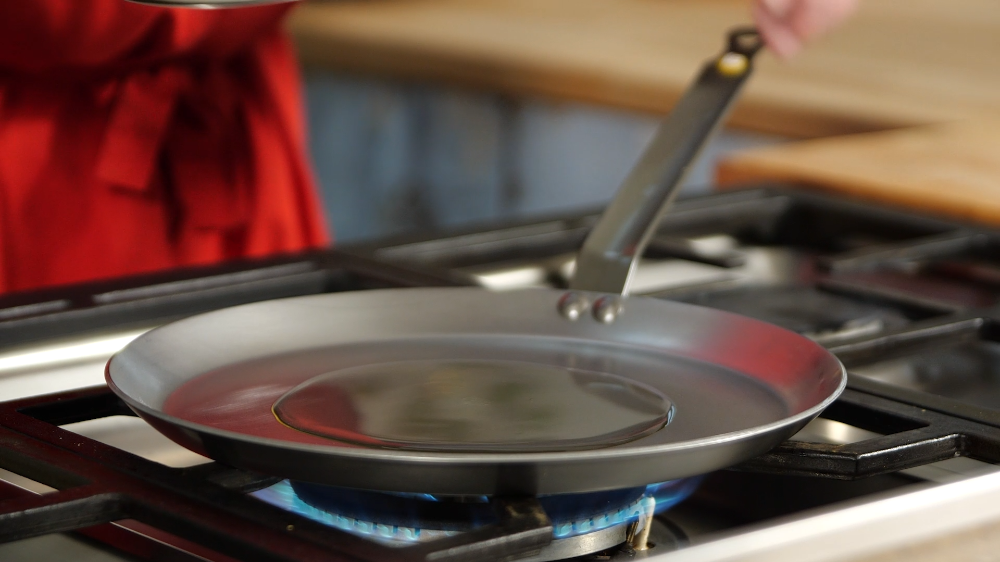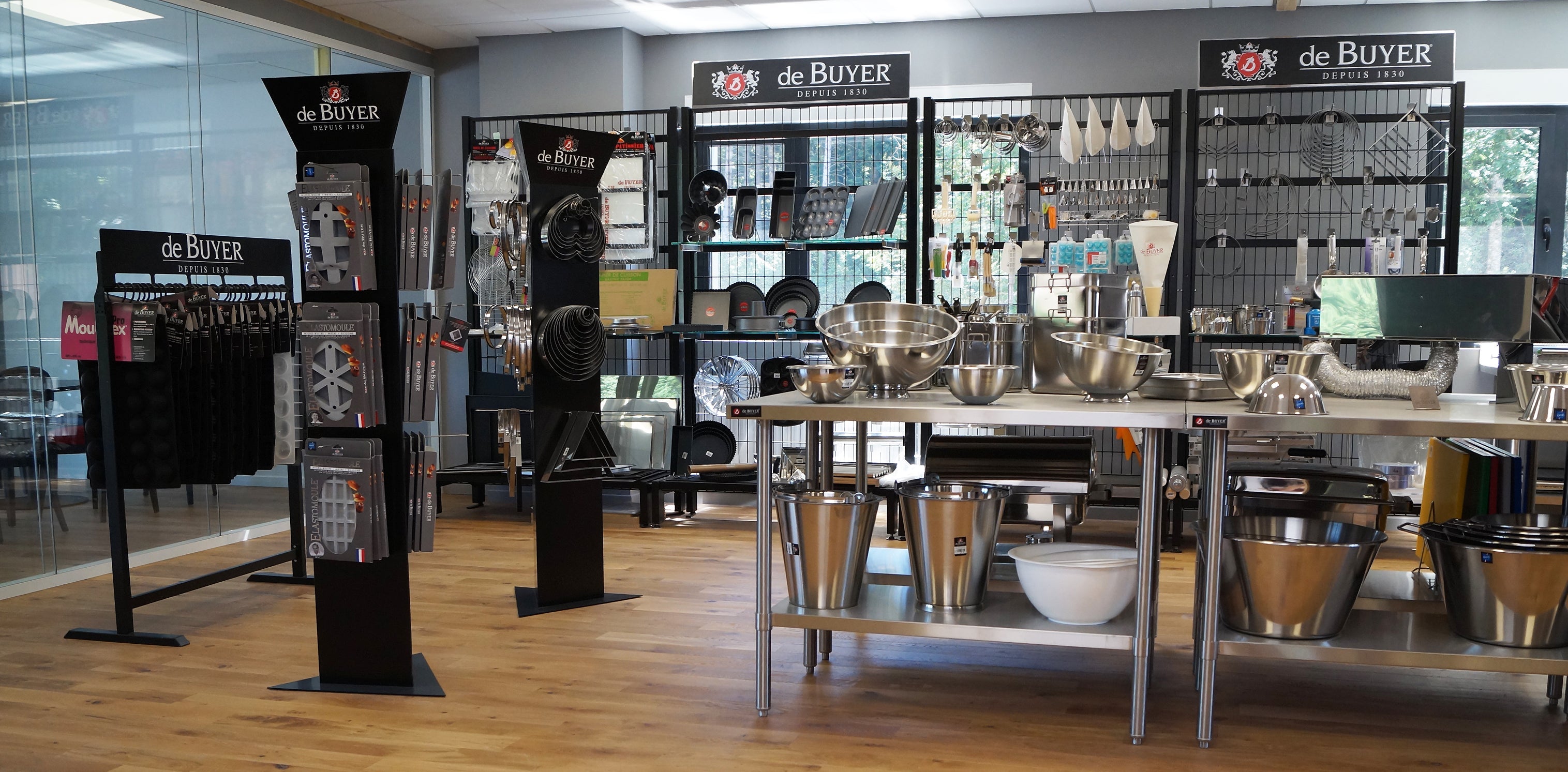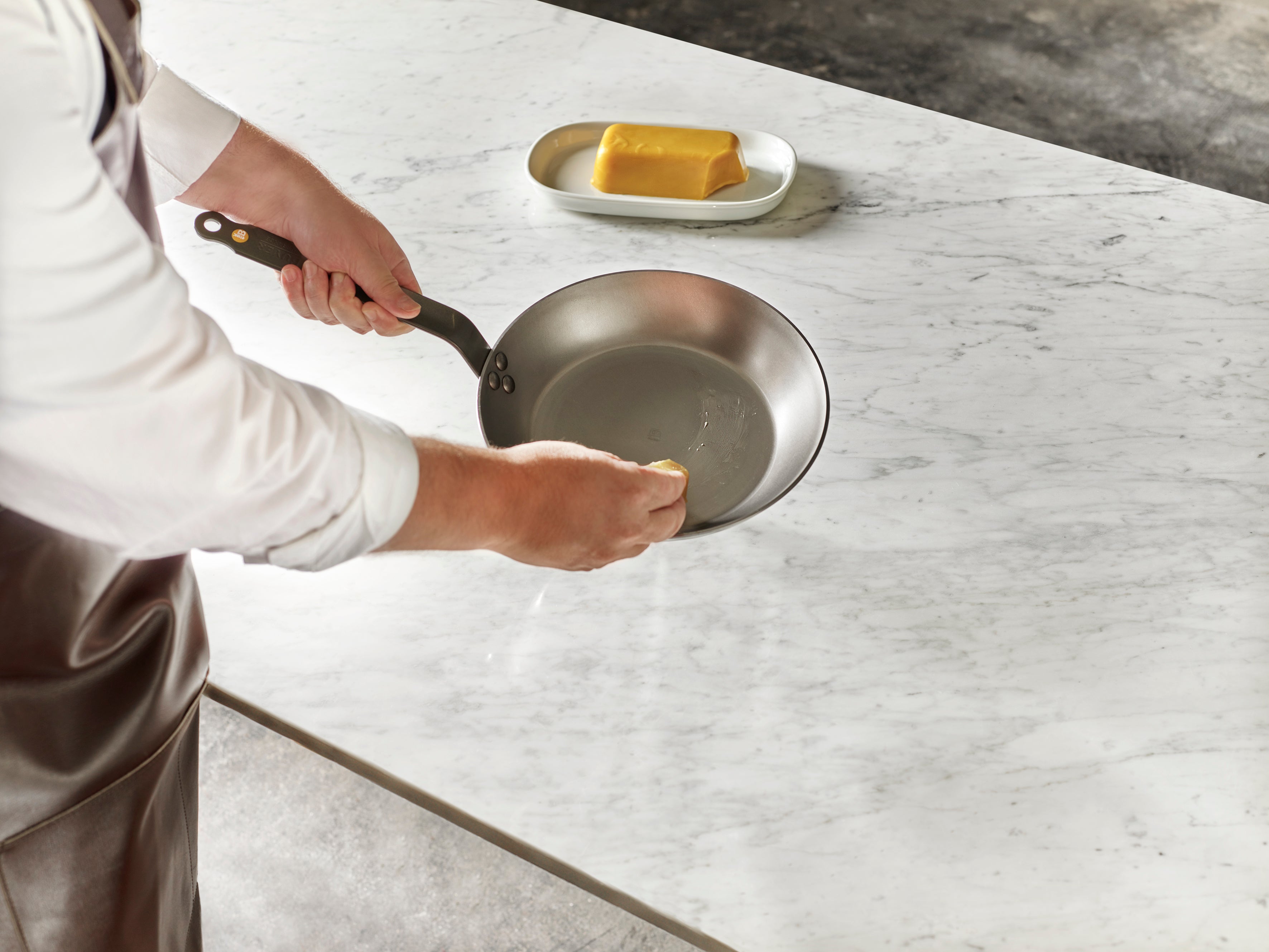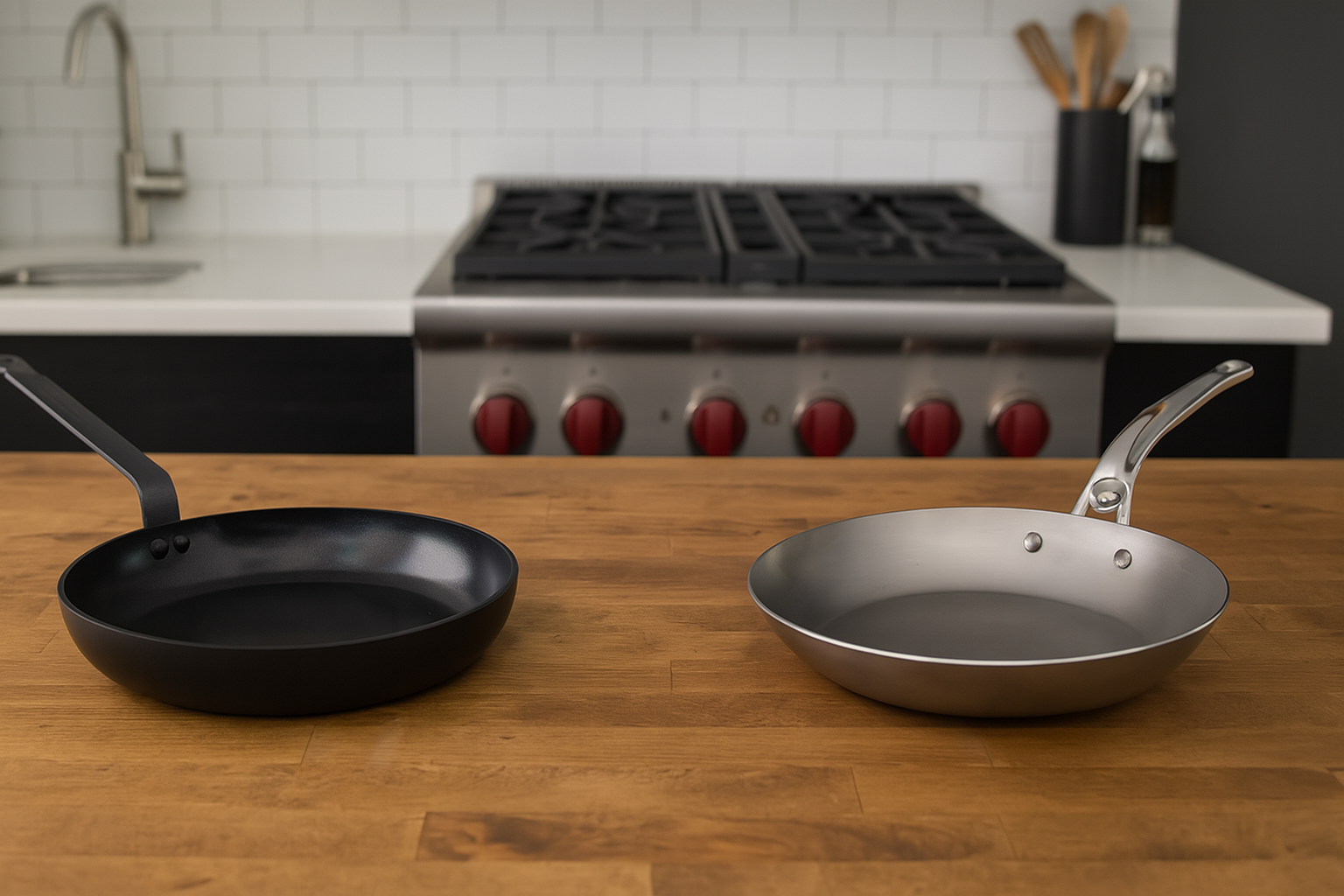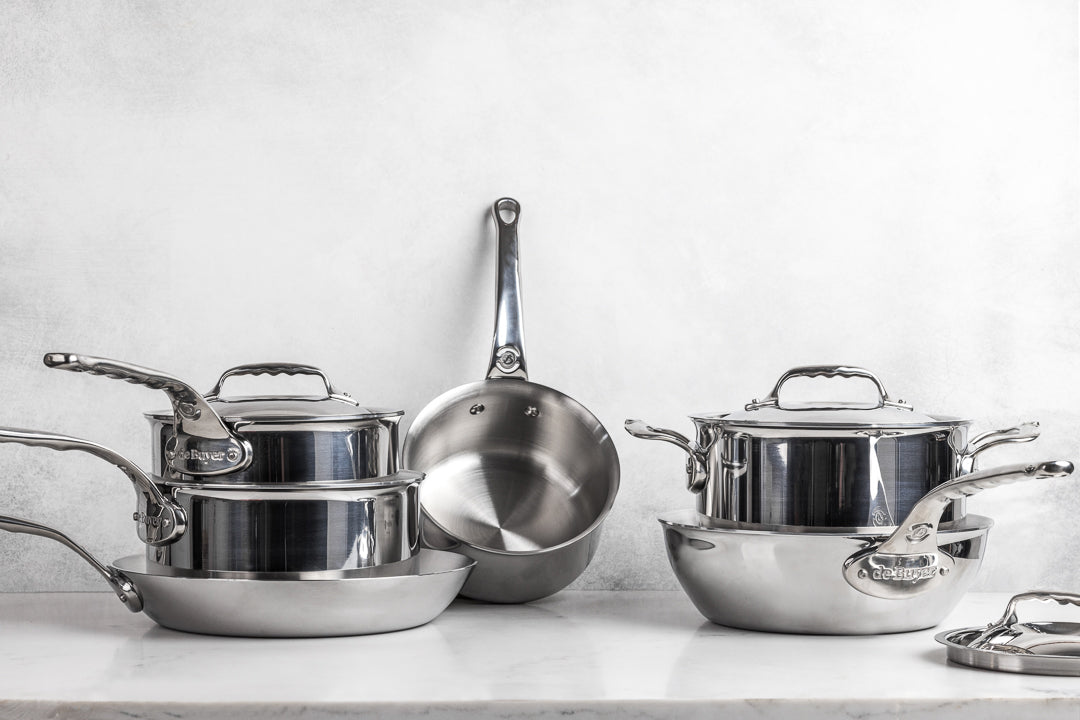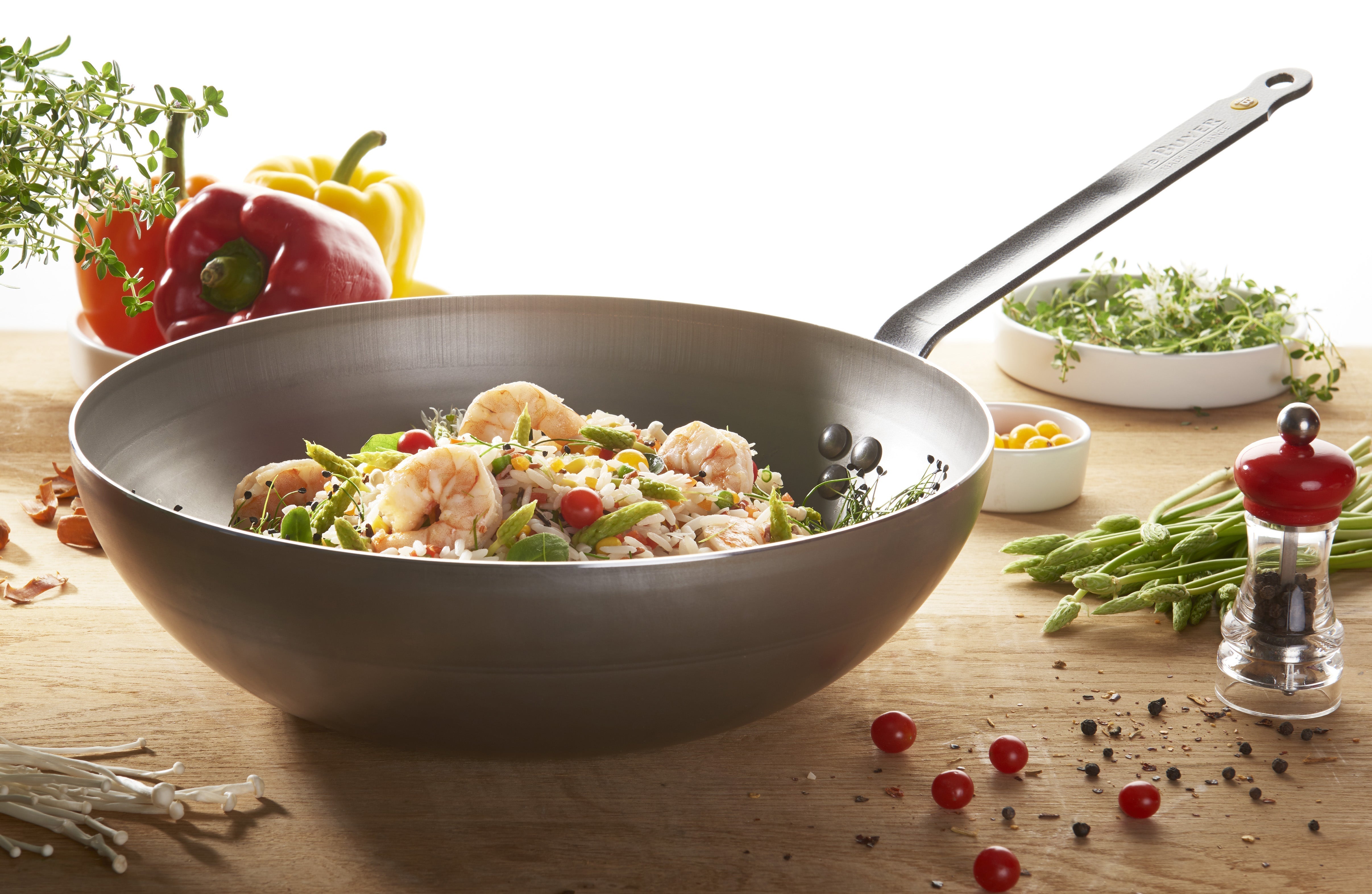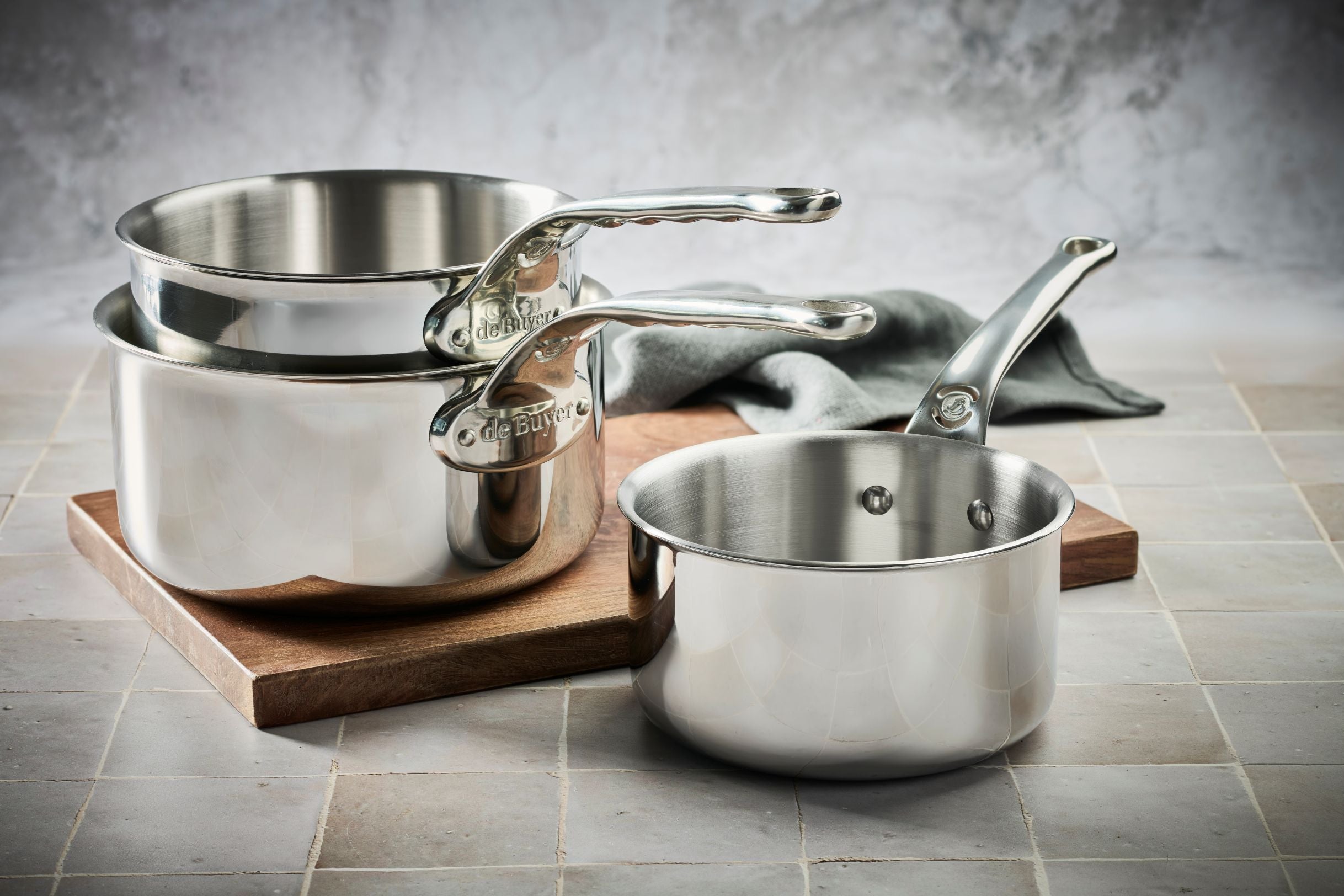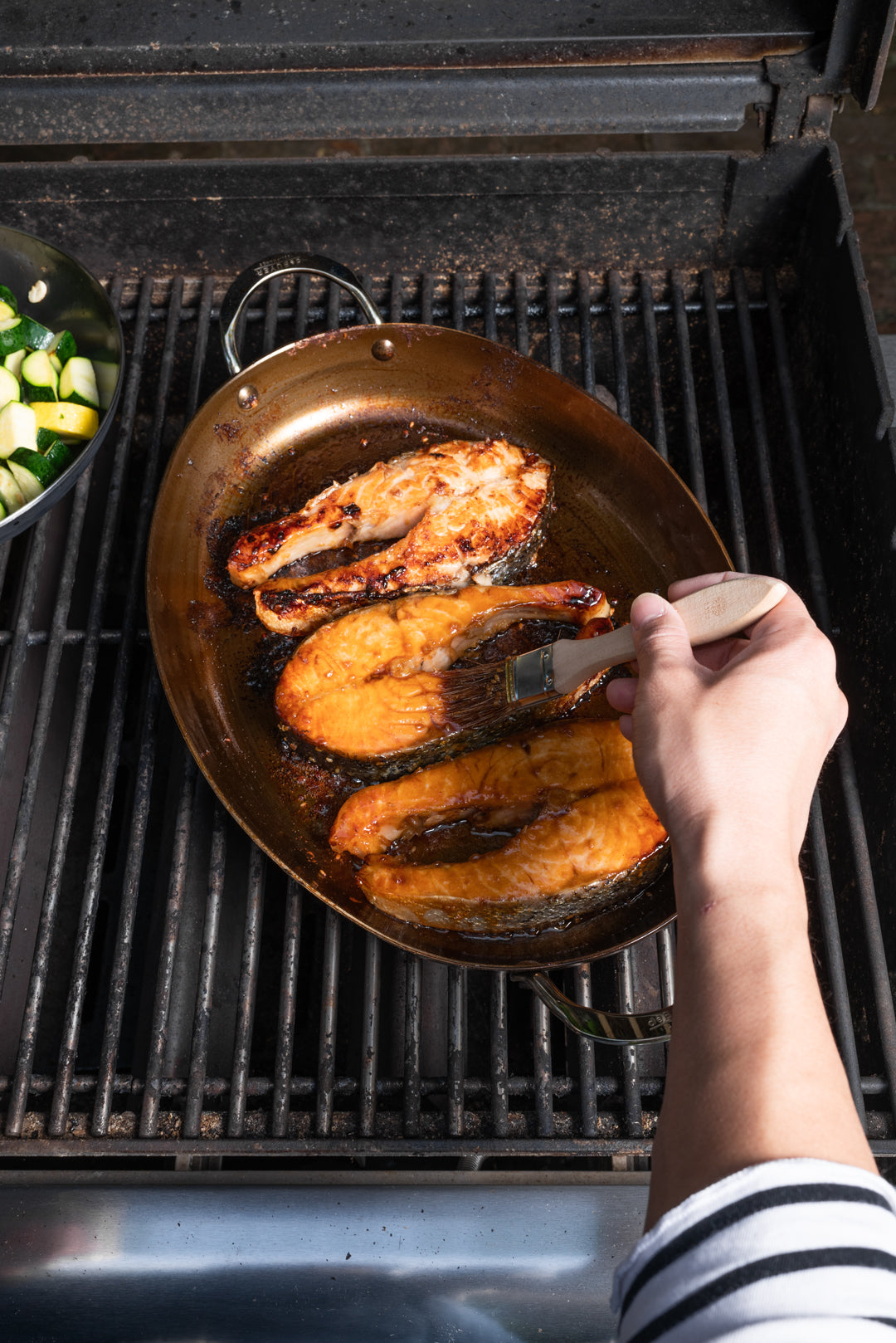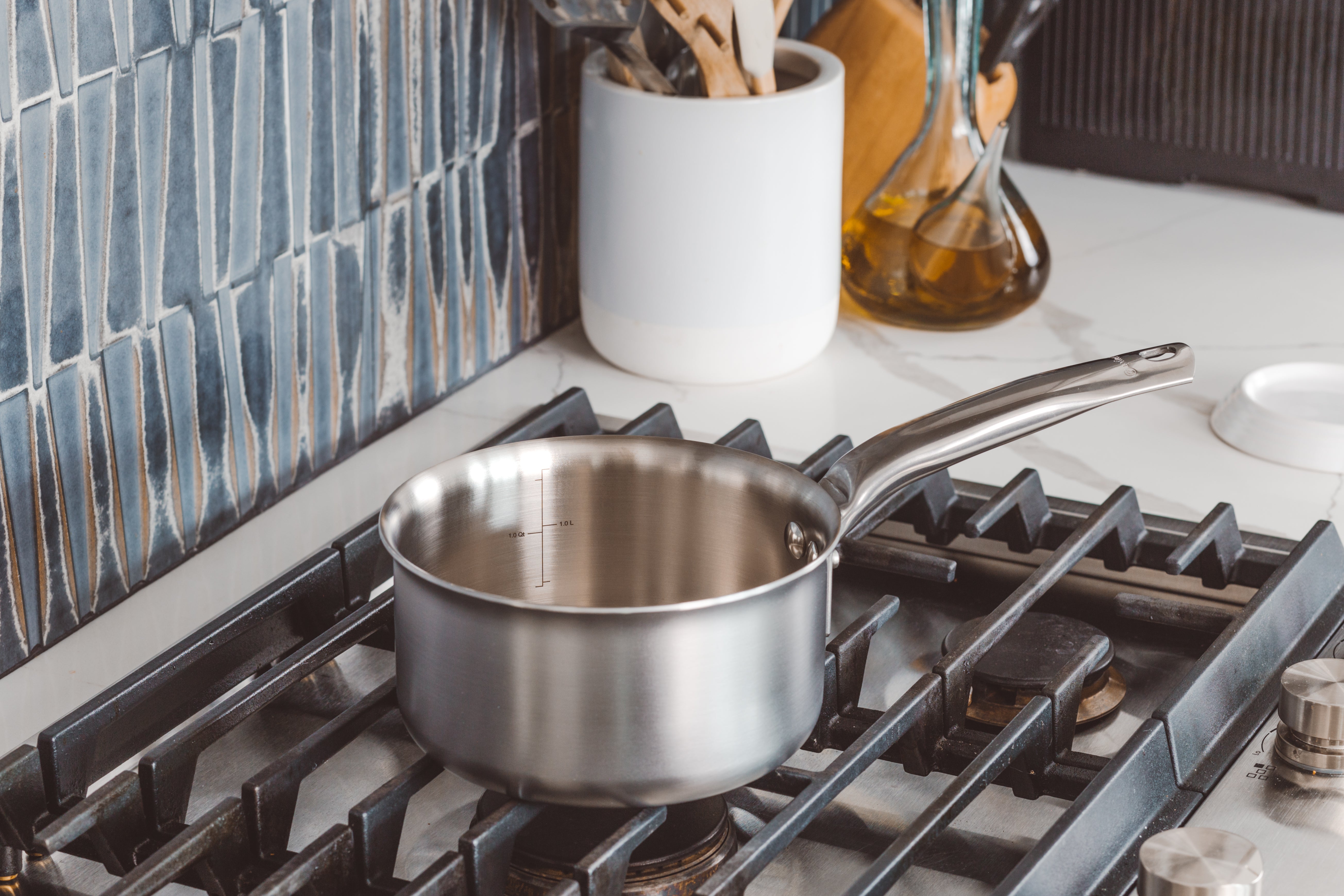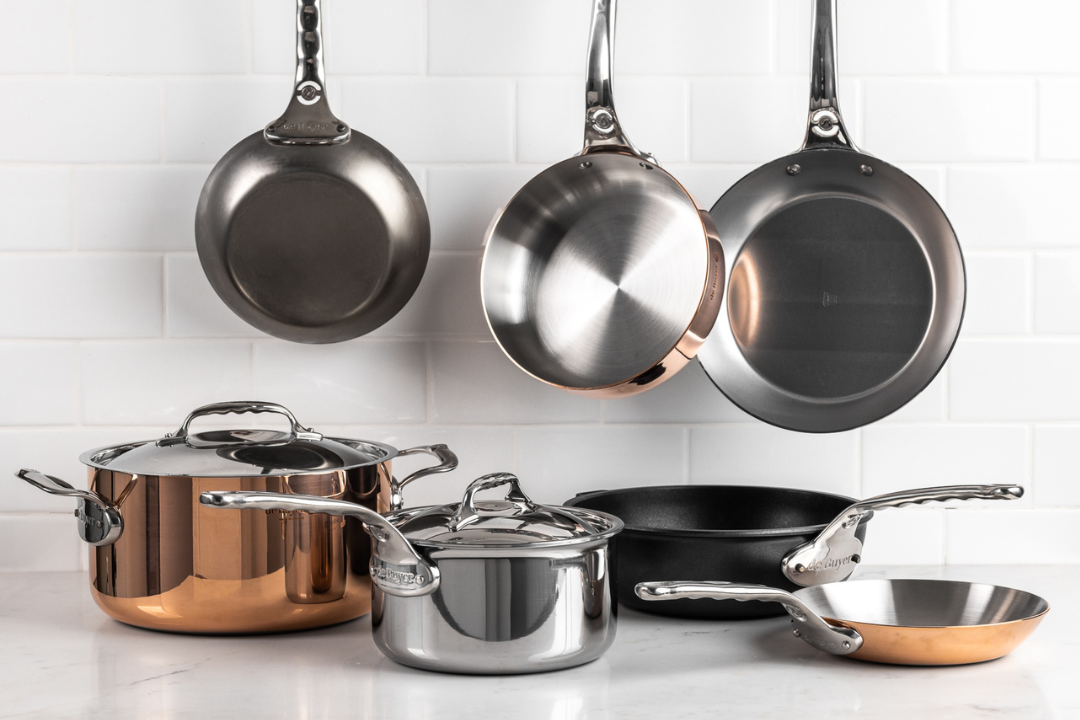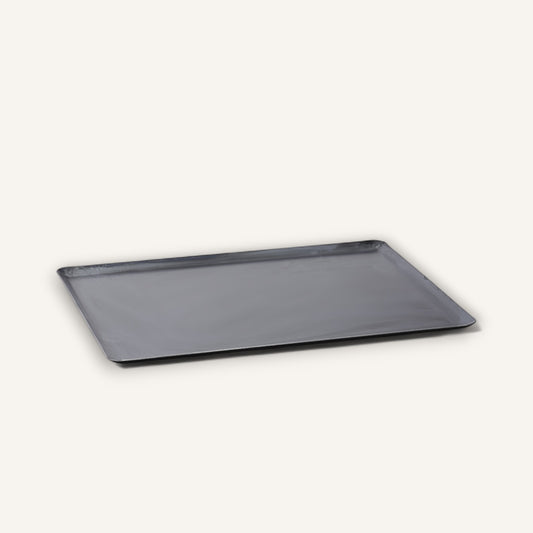Cast iron is a tried and true type of cookware, but other options are available on the market. If you’re looking for a cookware with the perks and benefits of cast iron, but is more lightweight, has better heat control, and has a smooth surface, then we have the solution! If you love cast iron, consider upgrading to carbon steel. At first, cast iron and carbon steel seem to be very similar. Both are made with heavy-duty metal that can conduct heat very well. However, there are differences in their cooking surfaces, cooking functions, and seasoning processes. Let's look at the similarities and differences to see if carbon steel might be a better option for your kitchen.
Need high-quality carbon steel pans to add to your at-home kitchen? At de Buyer, we carry professional-grade products that have been designed and manufactured in France.
WHAT IS CARBON STEEL?
Carbon steel is considered an alloy of iron and carbon. Most carbon steel cookware consists of 99% iron and 1% carbon. Unlike stainless steel pans with shiny surfaces, carbon steel will have a matte finish and eventually darken over time due to the natural seasoning process. That flat surface is the perfect option for searing delicate meats or fish, cooking up a French omelette that will slide right out of the pan.
You will find carbon steel in many kitchens, especially in France. These carbon steel pans heat up and cool down quickly. Carbon steel pans are durable and more lightweight than cast iron, making them a great choice to use inside your home, outside on the grill, or over a campfire.
Related: Carbon Steel Pan vs. Cast Iron: What's the Difference?
Carbon steel will heat up faster than cast iron, and cool down more quickly, so you have better control over the foods you’re cooking. Since carbon steel has a smoother surface than cast iron, its natural nonstick properties are more effective, so you don't have to worry about food sticking to the pan once you have proper seasoning on the pan. While carbon steel is heavier than aluminum or stainless steel pans, it is lighter than cast iron making it easier to use and for cooks to handle in the kitchen, especially when it comes to flipping and sauteing. De Buyer Carbon Steel pans are made with a thicker gauge metal than many other pans on the market, so they tend to be a bit heavier. This is a benefit, as the thickness of the pan makes it warp resistant and even more durable than the average carbon steel pan.
Carbon steel can be used on various cooktop surfaces, including gas, electric, and induction tops. If you want a durable and versatile option, you cannot beat carbon steel. Plus, our signature stainless steel handle on our Mineral B PRO series will stay cooler than those found on cast iron pans, so it can be a safer option. Not to mention, the signature handle allows the Mineral B PRO to be entirely oven, grill, and open fire safe.
How to Care For Carbon Steel Pans
Caring for carbon steel pans is essential to maintain their performance and longevity. Here are some tips to help you properly care for your carbon steel pans:
-
Seasoning: Before using a new carbon steel pan, season it by applying a thin layer of oil and heating it until it begins to smoke. Seasoning creates a natural nonstick coating.
-
Cleaning: After each use, gently clean the pan with a soft sponge or cloth and hot water. Avoid using abrasive cleaners or steel wool, which can damage the seasoning.
-
Drying: Thoroughly dry the pan with a towel to prevent rust formation. Even a tiny amount of moisture can cause rusting.
-
Oil Application: To further protect the pan from rust, apply a light oil coating after cleaning and drying. Oiling helps maintain the seasoning and prevents moisture from contacting the metal.
-
Removing Rust: If rust develops, gently scrub the affected area with a fine-grit sandpaper or scrubbing pad. Afterward, re-season the pan to restore its nonstick properties.
Following these care instructions ensures that your carbon steel pans remain in excellent condition, providing you with reliable and enjoyable cooking experiences for years.
Using Carbon Steel Pans for Cooking
Using carbon steel pans for cooking offers numerous benefits, but following proper techniques is essential. Here's a guide on how to effectively use carbon steel pans:
-
Preheating: Preheat the carbon steel pan over medium heat for a few minutes before adding any ingredients. Preheating ensures even heat distribution and enhances cooking performance.
-
Cooking Oil: Add a small amount of oil to the preheated pan, spreading it evenly across the cooking surface. Use oils with high smoke points, such as vegetable, canola, or grapeseed oil.
-
Temperature Control: Carbon steel pans heat up quickly, so adjust the heat as needed to prevent overheating. Unlike cast iron, carbon steel cools rapidly, offering better control over cooking temperatures.
-
Seasoning: The natural nonstick properties of carbon steel pans can be enhanced through proper seasoning. Regular use, oiling, and heating help develop a protective layer that prevents food from sticking.
-
Utensils: Use wooden, silicone, or heat-resistant plastic utensils to avoid scratching the cooking surface. Metal utensils can damage the seasoning and expose the underlying metal.
-
Cleaning: After cooking, gently clean the pan with hot water and a soft sponge or cloth. Avoid using harsh detergents or abrasive materials that can strip away the seasoning.
-
Storage: Ensure the pan is completely dry before storing to prevent rust. Apply a light coating of oil to maintain the seasoning and protect against moisture.
By following these guidelines, you can make the most of your carbon steel pans, enjoying their superior heat conductivity, durability, and natural nonstick properties for various cooking applications.
Is Carbon Steel Heavy?
One common concern when considering carbon steel pans is their weight. Carbon steel pans are heavier than some other materials but lighter than cast iron pans. While they may have some weight, carbon steel pans offer a good balance between durability and maneuverability.
The weight of carbon steel pans can vary depending on their thickness and construction. However, using thinner metal sheets in their formation compared to cast iron contributes to a lighter overall weight. This lighter weight makes carbon steel pans easier to handle, especially when flipping, sautéing, or maneuvering in the kitchen.
Despite their weight, carbon steel pans offer excellent heat distribution and retention properties, which can enhance cooking performance. The slightly heavier feel also provides a sense of sturdiness and quality.

Cast Iron: What Is It?
Cast iron is a cookware used for centuries due to its durability and excellent heat retention properties. It is made by melting iron and adding a high carbon content, typically 2 to 3.5 percent. This combination of iron and carbon gives cast iron its unique properties.
Cast iron pans have a rough, bumpy surface resulting from the casting process. This textured surface helps with creating a natural nonstick surface when correctly seasoned. Cast iron pans are known for distributing heat evenly and holding heat for a long time, making them ideal for searing, baking, and cooking.
However, cast iron pans require proper care and maintenance. They should be seasoned with oil to create a protective layer and prevent rusting. Cast iron pans should be cleaned gently, dried thoroughly, and coated with a thin layer of oil after each use to maintain their seasoning.
How to Care for a Cast Iron Pan?
Proper care is essential to maintain the performance and longevity of your cast iron pan. Follow these guidelines to ensure its longevity:
-
Seasoning: Season your cast iron pan before using it. Apply a thin layer of cooking oil, such as vegetable or flaxseed, to the pan's surface. Heat it in the oven at a specific temperature for a designated time to create a protective layer.
-
Cleaning: After cooking, allow the pan to cool down slightly. Use warm water and a soft brush or sponge to scrub any food residue gently. Avoid using soap, as it can strip away the seasoning. For stubborn food particles, use coarse salt as a natural scrub.
-
Drying: Thoroughly dry the pan with a towel to prevent rust formation. Even a small amount of moisture can lead to rusting.
-
Oil Application: Apply a thin layer of oil to the pan's surface after drying to prevent moisture contact and maintain the seasoning. Use a paper towel to spread the oil evenly.
-
Storage: Store the cast iron pan in a dry place to avoid moisture buildup. Place a paper towel or cloth between pans to prevent scratches if stacking pans.
-
Rust Removal: If rust forms on your cast iron pan, scrub it gently with steel wool or a scrubbing pad. Afterward, re-season the pan to restore its protective layer.
Remember, cast iron pans improve with use and proper care. Regular cooking and oiling contribute to developing a natural nonstick surface over time. With proper care, your cast iron pan can last for generations, providing exceptional cooking experiences.
Cooking With Cast Iron Pans: What to Know?
Cooking with cast iron pans can be a delight, but some essential things must be remembered. Here's what you should know when cooking with cast iron pans:
-
Heat Distribution: Cast iron pans have excellent heat retention and distribution properties. They heat slowly but hold heat for a long time, providing even cooking. Preheat the pan gradually to ensure even heat distribution.
-
Seasoning: Proper seasoning is crucial for a nonstick surface and to protect the pan from rust. Season the pan before using it, and the seasoning will improve over time as you cook with it. Avoid using acidic ingredients in the early stages of seasoning.
-
Cooking Oil: When cooking with a cast iron pan, use oils with high smoke points, like vegetable or canola. These oils can withstand high temperatures without breaking down or imparting off-flavors to the food.
-
Temperature Control: Cast iron pans retain heat well, so be mindful of adjusting cooking temperatures as needed. Lower heat settings are often sufficient for cast iron pans due to their excellent heat retention.
-
Utensils: Use wood, silicone, or heat-resistant plastic to avoid scratching the seasoning on the pan's surface. Metal utensils can damage the nonstick coating and expose the iron beneath.
-
Acidic Foods: Be cautious when cooking acidic foods in cast iron pans such as tomatoes or citrus. Extended exposure to acidic ingredients can erode the seasoning layer. It's advisable to build strong seasoning before cooking highly acidic dishes.
-
Cleaning: Clean the cast iron pan gently with warm water and a soft brush or sponge. Avoid using soap, as it can strip away the seasoning. Use coarse salt as a natural abrasive to remove stuck-on food particles if necessary.
Remember that cooking with cast iron pans requires patience and proper care. With time and proper maintenance, your cast iron pan will develop a beautiful, natural nonstick surface and provide you with years of reliable cooking performance.
Enamel Coating: How Does It Help With Cast Iron?
Enamel coating provides several benefits when it comes to cast iron pans. Here's how enamel coating helps with cast iron:
-
Protection: The enamel coating acts as a protective barrier on the cast iron surface, preventing direct contact between the food and the iron. This barrier helps to prevent the iron from leaching into the food, making it suitable for cooking acidic or alkaline dishes.
-
Non-Reactive Surface: Enamel is non-reactive, so that it won't react with acidic ingredients like tomatoes or vinegar. This feature makes enamel-coated cast iron pans a versatile choice for various recipes.
-
Variety of Colors: Enamel coating comes in various vibrant colors, allowing you to choose a pan that matches your kitchen aesthetic. It adds a touch of style and elegance to your cookware collection.
However, it's important to note that enamel coating can chip or crack if not handled carefully. Avoid using metal utensils or abrasive cleaning tools that can damage the enamel surface.
Additionally, enamel-coated cast iron pans may achieve a different level of heat retention than traditional cast iron pans.

CARBON STEEL VS. CAST IRON
Some of carbon steel’s best features are its durability and its super smooth and slick cooking surface. Like Carbon Steel, Cast iron is another alloy of carbon and iron. Cast iron does have more carbon than carbon steel, with most levels at 2 to 3.5 % per pan. The cast iron pan will have a bumpy textured surface with its extra carbon content and from the rough grooves of the casting mold. Cast iron also tends to be more fragile and brittle than carbon steel, as they are more susceptible to cracking if it falls or is dropped. Since it is thick and formed by being pressed from metal sheets rather than being formed in a cast, carbon steel pans will not break, regardless of the wear and tear that they are put through and are virtually indestructible. As an added bonus the smooth cooking surface makes the natural nonstick features even better than cast iron, as foods will easily slip and slide around in it.
Related: Cookware Materials Guide
Cast iron does hold heat longer than carbon steel, but it also take longer to heat up. While you might think that is an advantage, it makes it more difficult to control the temperature of the foods you are cooking and can lead to burned or overcooked food. With carbon steel, the thinner metal heats up and cools down more quickly than cast iron, giving you better control over the cooking temperature without any hot spots.
Cast iron pans and skillets are extremely heavy. In fact, they can be twice as heavy as carbon steel. While carbon steel overall can be heavy, it is more lightweight than cast iron, and with longer and more ergonomic handles, carbon steel offers more movability and ease of use in the kitchen. A cast-iron handle is short and straight, leading to less maneuverability and potential strain on the wrist.
WHICH ONE IS BETTER?
In your kitchen, cast iron and carbon steel both have their place. Both materials require seasoning, retain heat well, and have naturally nonstick properties. Let’s compare them side by side with each feature:
- Seasoning: Both materials will need to be seasoned in order for them to perform their best. Carbon Steel can be seasoned on the stove top or in the oven with a high smoke point oil in order to build up the naturally nonstick surface. The same goes with cast iron, and while many cast iron pans can be purchased pre-seasoned, you won’t have control over what type of oil is used or how it is seasoned initially. With de Buyer Carbon Steel, you have control over the entire process.
- Maintenance: Carbon Steel is easy to care for. Often times, after cooking it just needs to be wiped down with a paper towel before being stored away. If any food gets stuck to the pan, it can be deglazed with hot water to loosen up any stuck on bits, then scraped or scrubbed to remove it. Anytime the pan gets wet it is important to dry it thoroughly, and it is always a good idea to rub a light coating of oil on it before storing it away. Because of its grooved surface, foods might be more likely to stick to the surface of cast iron, which also prevents a simple wipe down with a paper towel from being enough to clean the pan. Like carbon steel, it should always be thoroughly dried and wiped down with oil, but the cleaning process might be a bit more strenuous.
- Heat retention and control: Carbon Steel has the best of both worlds between cast iron and stainless steel. Like stainless steel, it heats up and cools down more quickly than cast iron, but it still has some great heat retention properties. Cast iron is good when it comes to retaining heat for longer periods of time, but it can lead to burnt or overcooked food.
- Nonstick properties: With a proper seasoning, both carbon steel and cast iron have naturally nonstick properties, which is ideal for those who do not want to use nonstick coated aluminum pans with chemical coatings. Because of its smoother surface, carbon steel’s nonstick abilities really shine through and let things like fried eggs slide around the pan.
- Weight: it is no secret that cast iron is very heavy. Carbon steel is also heavier than many other materials, but it is more lightweight than cast iron, making it easier to maneuver and cook with.
If you want to take these pans outside, they can both handle the high heat. Carbon steel pans are lighter in weight, and they are easier to move from the stove (or campfire) to the oven, and to the table. Many professional chefs love using carbon steel pans, mainly due to the ease of use and heat retention and control abilities of these products.
Related: Skillet vs. Pan: The Differences and Uses




